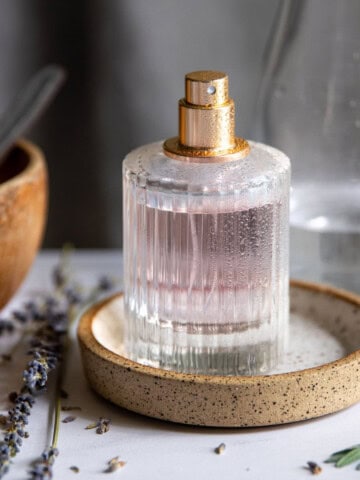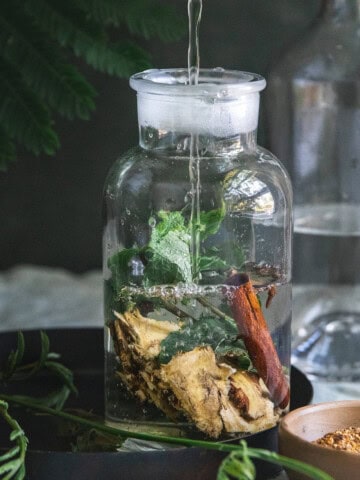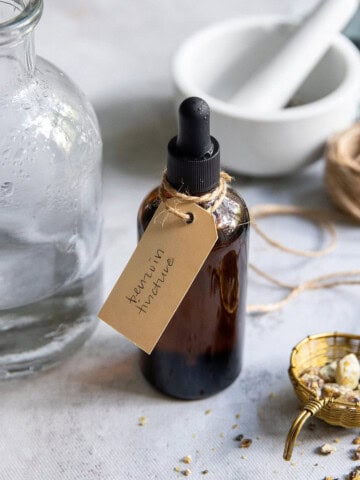Roses are so many things. Sure, they're pretty to look at and they smell amazing, but they are so. much. more. Here's our easy step-by-step tutorial on how to make rose water, so you can control what goes into it and also save a few bucks.
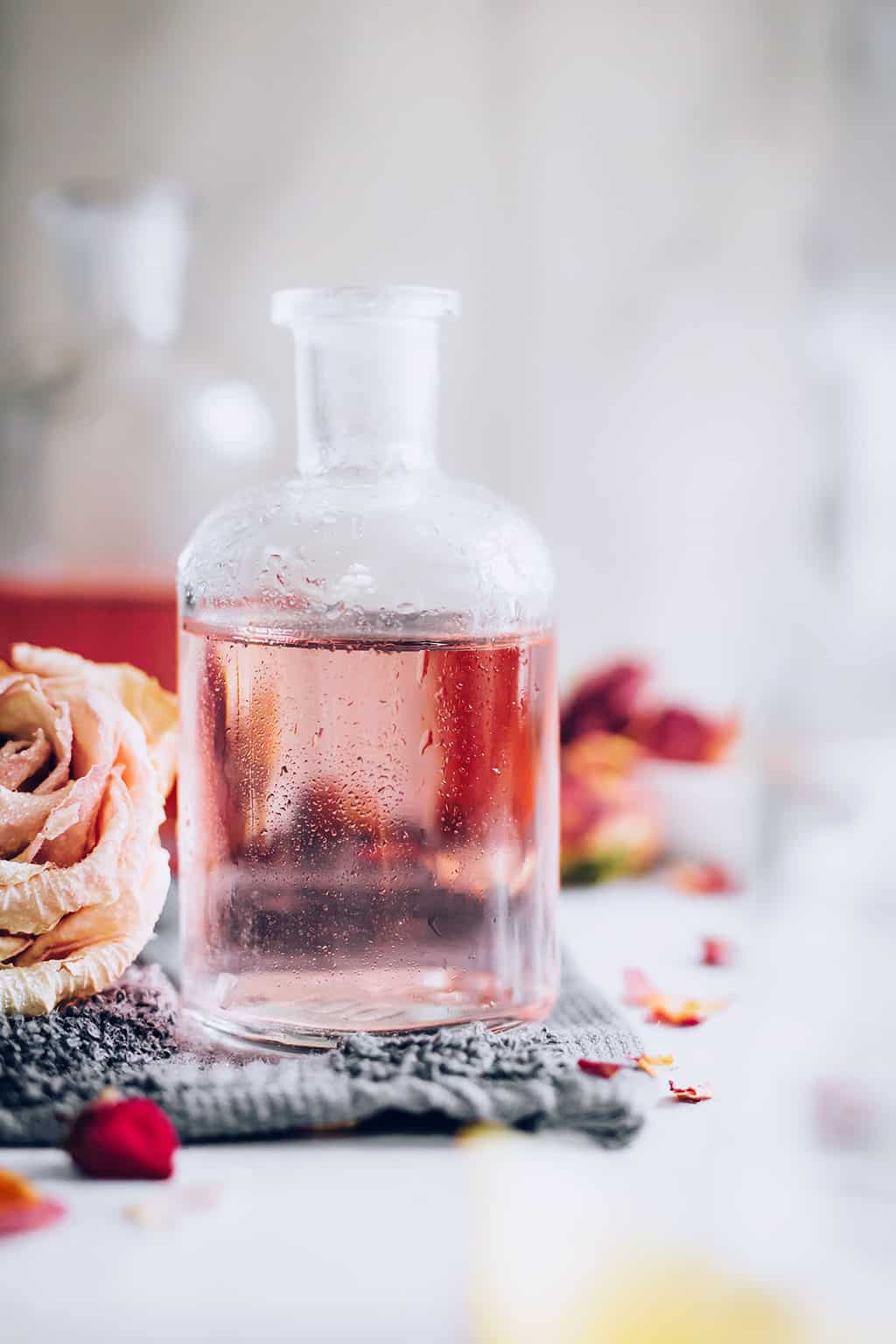
I love to spritz rosewater on my face first thing in the morning because, well, it's pleasant, but it's also an anti-inflammatory—the first defense against swollen, puffy eyes.
And can we talk about the toning aspect of rosewater? Second to none in my book.
Rosewater mists can cost a pretty penny through your favorite beauty retailer—I brought back a bottle from a trip to Paris that I rationed like liquid gold. But it's so darn easy to make on your own!
Jump to:
Skin Benefits of Rosewater
Rosewater is known for its versatile benefits for the skin, attributed to its anti-inflammatory, antioxidant, and hydrating properties.
Rich in phenols, flavonoids, and other antioxidant compounds [source], rose petals have been found to have many therapeutic benefits, from anti-wrinkle effects [source], to protecting the skin from DNA damage [source], and suppressing the growth of cancer cells [source].
Thanks to its anti-inflammatory properties, rosewater can help soothe the skin, reducing redness in irritated skin and getting rid of acne.
Rosewater acts as a natural toner due to its astringent properties, tightening pores, and restoring suppleness for a glowing complexion.
What are the best roses for rose water?
The quality of your rosewater heavily depends on the type of roses you use. For best results, we recommend using home-grown roses without pesticides or organic roses that are super fragrant, such as Damask or English roses.
Beyond that, roses that are pink or red tend to have a stronger scent, while yellow or white roses may have more of a lemony, violet, or clove scent. Let your nose be your guide and choose whatever rose has a scent that you enjoy.
If you don't plan to use the rosewater on your skin and are simply going to use it as an air freshener or room spray, you can make rose water with store bought roses. Otherwise, use organic to make sure there are no pesticides.
4 Ways To Make Your Own Rose Water At Home

1. Distillation Method For Pure Rosewater
Distillation is a more traditional and complex method of making rosewater at home, yielding a pure and potent product. It requires specific equipment but produces high-quality rosewater.
Ingredients + Supplies
- 6–8 cups of extremely fragrant (organic, if possible!) rose petals
- Distilled water
- Ice cubes
- Large pot with a lid
- Tongs
- Brick or small bowl weighted down with kitchen weights
- Shallow, wide-mouth bowl
- Glass jar or vessel with a lid to store rosewater
- Measuring cup with a spout or a kitchen funnel
Step 1: Prepare the Rose Petals
Start by removing the petals from your roses, separating them from the stem, and shaking out any stamen that might have gotten caught up in the petals. Gently rinse the rose petals to remove any dirt or residue.
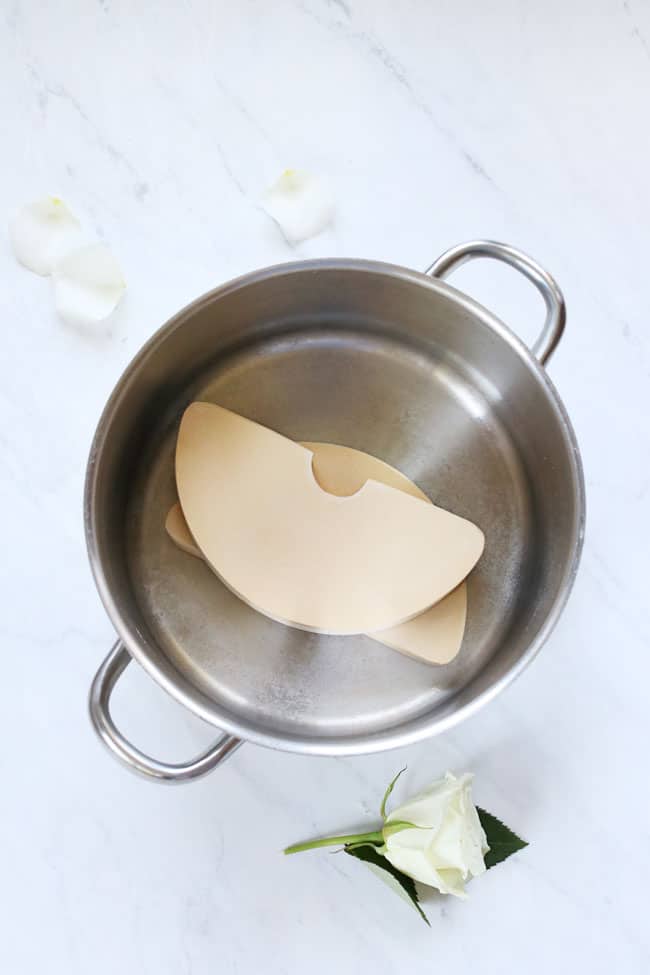
Step 2: Prepare the Pot
Place a brick, a heavy bowl, or a cup filled with kitchen weights in the bottom of your pan. Then place a wide-mouth bowl on top of the brick or weighted bowl.
Before moving on to the next step, place the lid upside down on your boiling pot (you’ll see why later on) to make sure it closes. If your bowls are too tall, you won't get a good, tight fit with your lid.
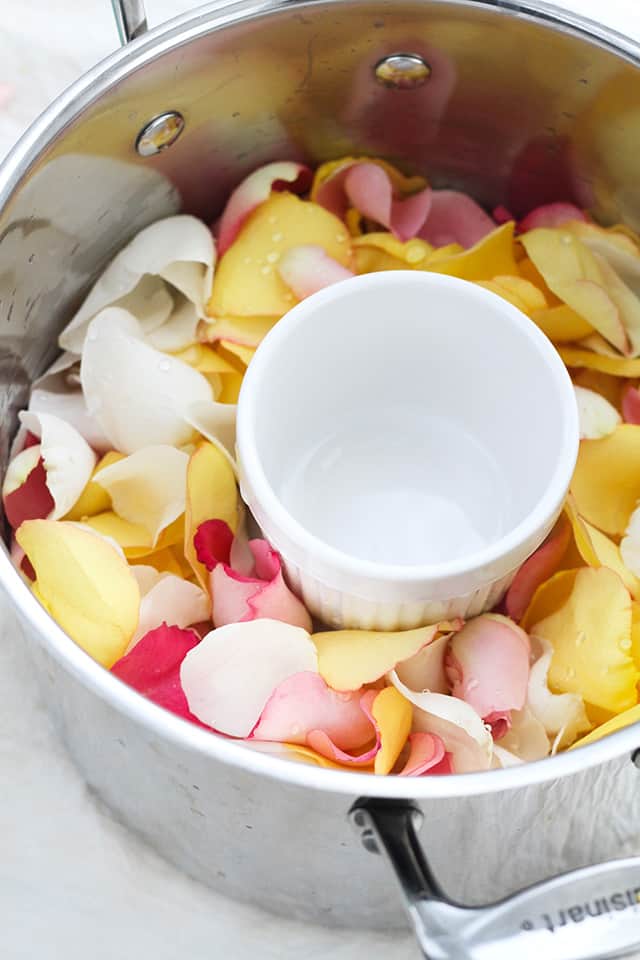
Step 3: Add Petals to Pot
Once you've got the weight and bowl inside your pot, start filling up the pot with petals. Place your fragrant rose petals around the bowl in the center.
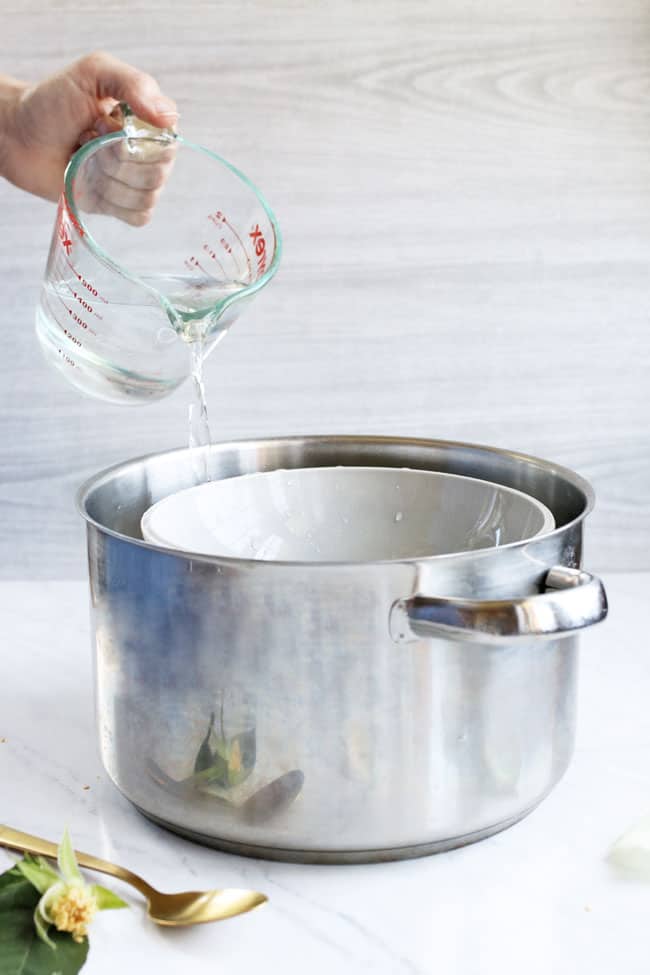
Step 4: Add Distilled Water
Then pour the distilled water around the sides of the bowl and lightly submerge the flower petals. I ended up using about 6 cups of water.
The bowl in the center should be sitting above the level of the water and petals.
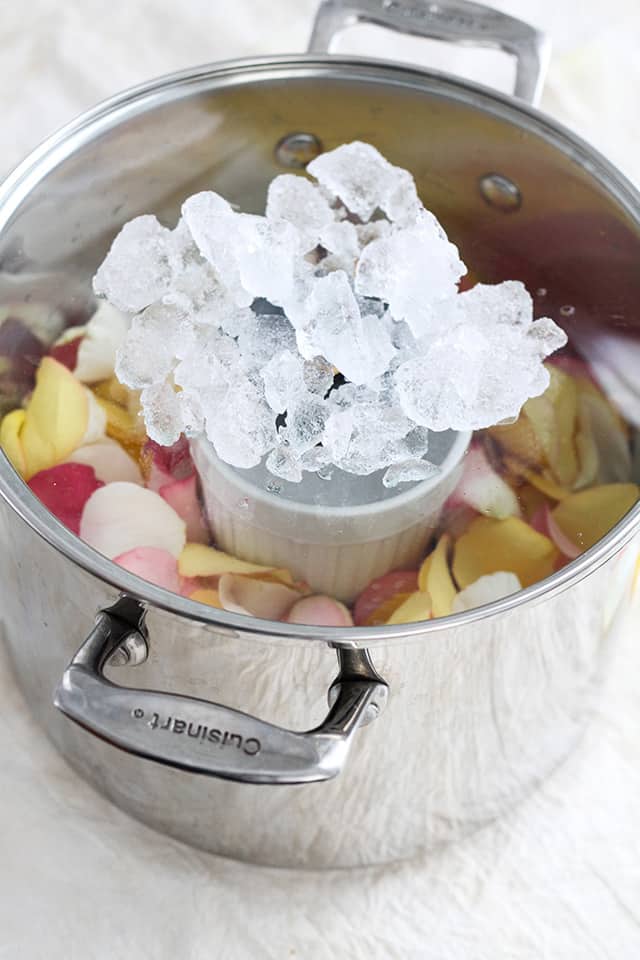
Step 5: Put Lid on Upside Down and Add Ice
Invert the lid of the pot and place it on top. Turn on the heat to bring the water to a simmer.
Place ice on top of the inverted lid and replace with more as it melts. As the steam condenses on the underside of the lid, it will drip down to the center, eventually finding its way into the wide-mouth collection bowl.
Step 6: Simmer + Collect Rosewater
Reduce heat to low. Keep adding ice as needed to encourage condensation.
After about 20-30 minutes, or when the petals have lost their color, turn off the heat and let everything cool. The water collected in the bowl is your rosewater.
Through the magic of distillation, you've now made your very own pure rosewater, ideal for skincare benefits!
Step 7: Remove Inner Bowl + Bottle Rose Water
Using your tongs, carefully remove the collection bowl from the pot, pour the yummy smelling contents into a sterilized jar with a lid, and seal it.
A kitchen funnel makes this process easy, but you can also pour the contents into any old measuring cup with a spout to make it work.
Store it in the refrigerator to prolong its shelf life.
2. Simmering Method for Rose-Infused Water
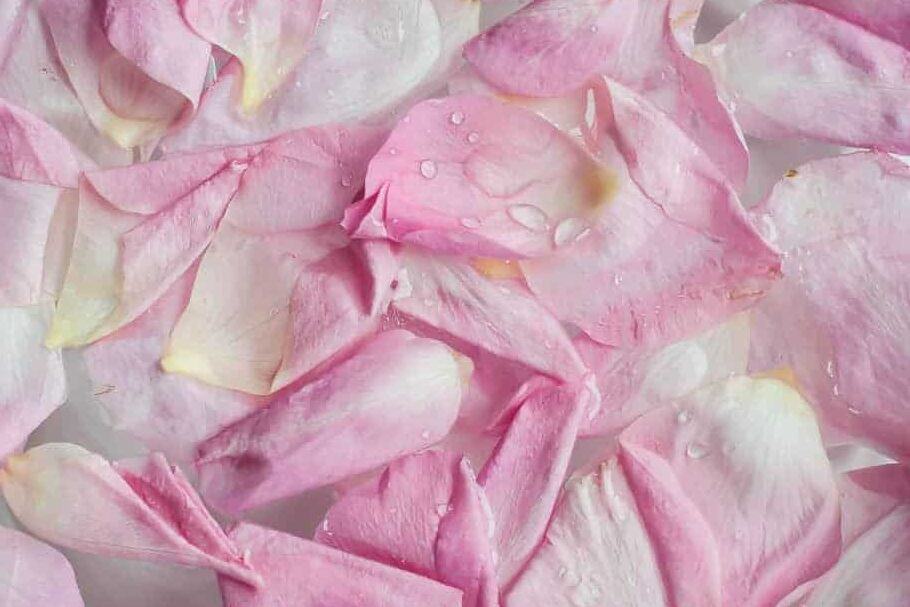
Here's a straightforward way to make DIY rosewater at home using the simmering method, which requires no special equipment:
Ingredients:
- Fresh rose petals (from about 3-4 roses)
- Distilled water
Equipment:
- A large pot with a lid
- A strainer
- A bowl
- A spray bottle or jar for storage
Instructions:
Place Petals in the Pot: Put the cleaned rose petals in the pot and cover them with distilled water. Use just enough water to cover the petals, as too much water will dilute your rosewater.
Simmer: Place the pot on the stove and bring the water to a simmer over low heat. Cover the pot with a lid. Let the petals simmer until they lose their color, which usually takes around 20-30 minutes. Avoid boiling, as high heat can destroy some beneficial properties of the rose petals.
Cool and Strain: Turn off the heat and allow the mixture to cool completely. Once cool, strain the mixture using a strainer to remove the petals, ensuring you're left with just the rose-infused water.
Store: Transfer the rosewater into a clean spray bottle or jar. Store it in the refrigerator to prolong its shelf life; it should be good for up to a month.
3. Cold Infusion Method for Gentle Rosewater
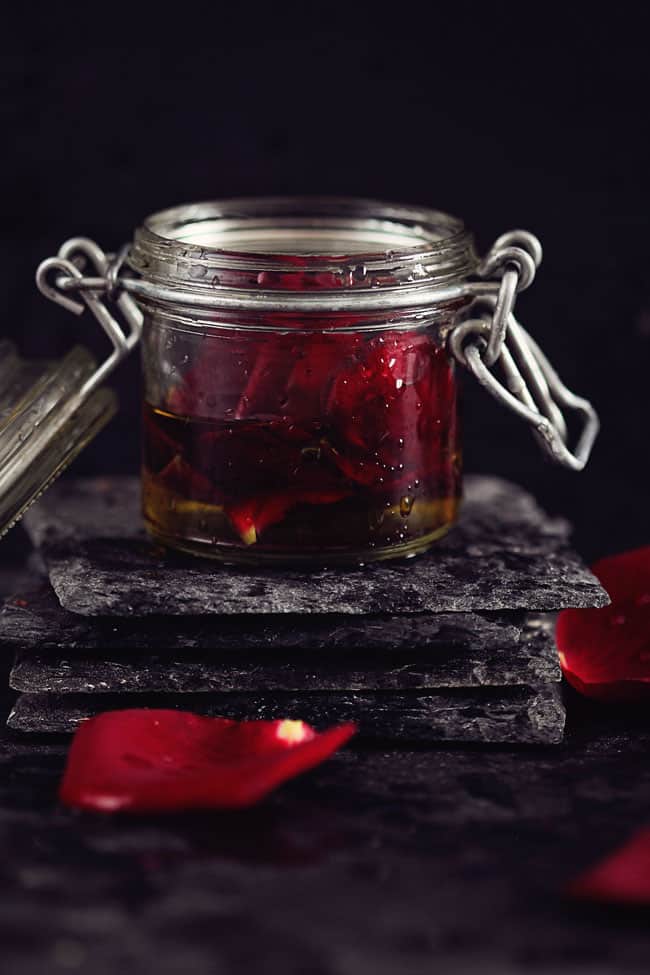
The cold infusion method is excellent for making a milder homemade rosewater, ideal for sensitive skin or culinary uses, without applying heat.
Equipment Needed:
- A glass jar with a lid
- Fresh or dried rose petals
- Distilled water
Instructions:
- Prepare the Petals: Fill the glass jar with fresh or dried rose petals. If using fresh petals, ensure they are clean and pesticide-free.
- Add Water: Pour distilled water over the petals until they are completely submerged. For a stronger rosewater, use fewer petals; for a milder one, use more.
- Seal and Store: Close the jar tightly with its lid and place it in a cool, dark place for 24 to 48 hours. The longer you leave it, the stronger the infusion will be.
- Strain and Store: Strain the rose petals from the water using a fine mesh sieve or cheesecloth. Transfer the rosewater to a clean, sterilized container. Refrigerate to extend its shelf life.
4. Simmer Method with Dried Roses
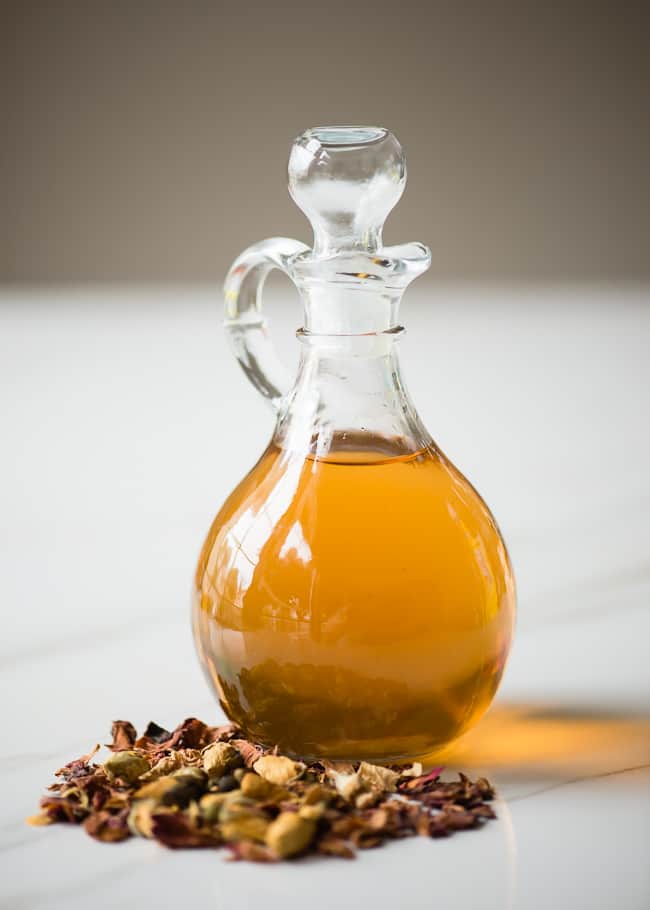
Making rosewater with dried roses is a simple and effective way to harness the beauty benefits of roses all year round, especially when fresh roses are not available. Here’s a rose water recipe using the simmering method, specifically adapted for dried rose petals:
Ingredients:
- 1 cup of dried rose petals
- 2 cups of distilled water
Equipment:
- A large pot with a lid
- A strainer or cheesecloth
- A bowl or large measuring cup
- A sterilized bottle or jar for storage
Instructions:
- Prepare the Petals: Ensure that the dried rose petals are clean and free from any debris. If they're not pre-packaged as food-grade, give them a gentle shake or a quick visual inspection to ensure there's no dust or particles.
- Simmer the Petals: Place the dried rose petals in the pot and cover them with the 2 cups of distilled water. It's important not to use too much water, as you want to create a potent rosewater without diluting it unnecessarily.
- Heat the Mixture: Bring the mixture to a simmer over low heat. Cover the pot with a lid to prevent the evaporation of too much water. Let it simmer for about 20-30 minutes, or until the water takes on the color of the petals and the petals have lost their color, indicating that their essence has been infused into the water.
- Cool and Strain: After simmering, remove the pot from the heat and allow it to cool to room temperature. Once cooled, strain the mixture using a strainer or cheesecloth into a bowl or large measuring cup. Make sure to squeeze out all the liquid from the petals to maximize the yield of your rosewater.
- Bottle the Rosewater: Transfer the strained rosewater into a sterilized bottle or jar. If you have a funnel, it can help make this process cleaner and easier.
- Storage: Store your homemade rosewater in the refrigerator to keep it fresh. It should last for several months if kept cool and sealed properly.
11 Ways To Use Rosewater In Your Skincare Routine
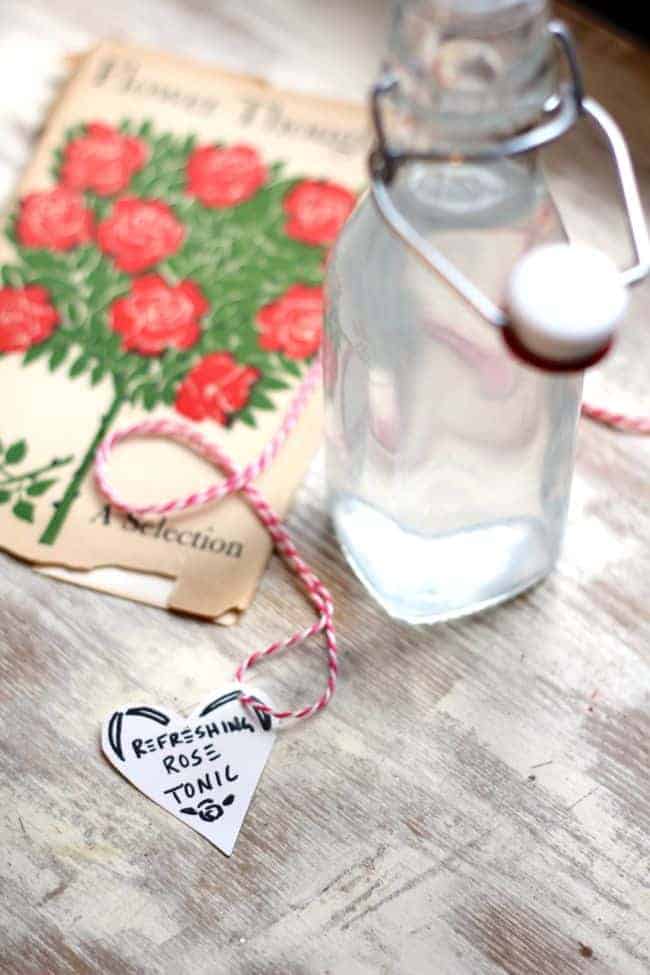
1. Slow the aging process
Rosewater can help soften the skin, which can reduce the appearance of lines and wrinkles when used regularly. We’ve tested the ultimate anti-aging serum made from rosehip oil and rosewater.
Not only is it great for your skin, it smells absolutely fabulous! But, how could it not when full of roses and essential oils?
2. Tone your skin
Rose water acts as a natural toner due to its astringent properties. It tightens pores and restores suppleness for a glowing complexion. Best of all, it’s easy to make your own rosewater toner with dried roses.
3. Treat frustrating acne
The unfortunate truth is that acne can follow us into our older years. Luckily, rosewater contains great anti-inflammatory properties to help soothe the skin and reduce redness and irritation.
And it's naturally antibacterial and antiseptic! Mix it with Moroccan red clay and avocado in this homemade mask to replenishe and clear the skin.
4. Deep clean your pores
Rosewater is a great cleanser and aids in removing oil and dirt accumulated in clogged pores, leaving your with a fresh clean face. Plus its powerful antioxidants help to strengthen skin cells and regenerate skin tissues.
5. Make a rose water + pink clay soap
The pH of rosewater is closer to that of skin, helping to balance the skin's pH levels, reducing excess oil and keeping your skin tone in check.
By cooking up this easy rosewater clay soap, you can smell fresh after every bath. Plus, this is a simple way to make your rosewater last a long time.
6. Hydrate your sensitive skin
Rosewater helps in hydration, revitalizing, moisturizing, and smoothing out the skin. It is often used as a natural moisturizer, making it ideal for dehydrated or dry skin types. The anti-inflammatory properties also help ease morning puffiness, as you'll find after using this face mist for a few days.
7. Cleanse your skin
A simple homemade cleanser whipped up with probiotic capsules is a great way to start introducing live bacteria into our skincare. And this easy micellar water cleanser is perfect for skin that’s prone to breakouts, but soothing and gentle enough for sensitive skin as well.
8. Condition your hair
Yes, you can use rosewater on your hair! It make an excellent rinse and provides hair with all day nourishment. Use this anti-frizz conditioner on wet or dry hair to lightly condition hair and keep flyaways under control without weighing you down.
9. Soothe + repair puffy eyes
Mix cucumber with rosewater and apply to tired eyes for an instant soothing sensation. Rich in ascorbic acid and phytochemicals, cucumbers help tighten the skin, de-puffing the under-eye area.
This rosewater puffy eye treatment is also extremely easy: simply refrigerate your rosewater for a half an hour and apply around the eyes with a cotton pad.
10. Fight sagging + cellulite
Try an Icelandic body treatment and facial, which includes rosewater as a soothing, nourishing ingredient that your skin will love.
11. Add shine to hair
Clean, soothe and nourish the scalp with rosewater, and benefit from its anti-frizz, hair softening properties at the same time.
What's your favorite way to use rosewater in your beauty routine?
FAQ
If you store your rosewater in the refrigerator in a sealed jar or bottle, it can last up to six months.
To avoid pesticides and chemicals, I would recommend using homegrown or organic roses to make rosewater. However, if you have store-bought roses that you'd like to put to good use rather than just tossing once they start to wilt, you can still use them to make your own rosewater. In this case, you may want to avoid using the rosewater on your skin and simply use it as an air freshener or room spray instead.
Organic or homegrown roses are best for rosewater that will come into contact with your skin. I've read that English roses, French roses, and cabbage roses are the best choices as far as types of roses.
Beyond that, roses that are pink or red in color tend to have a stronger scent, while yellow or white roses may have more of a lemony, violet, or clove scent. Truly, I'd suggest letting your nose guide your decision—choose whatever particular rose has a scent that you enjoy the most.
Aside from spritzing it on your skin—to tighten pores, hydrate, reduce redness, and help smooth fine lines and wrinkles—rosewater has lots of uses around the house and in your beauty routine. You can add it to your bath, mist it on linens and towels to keep them fresh, or use it as a simple air freshener.
If you're using organic rose petals, you can also add rosewater to teas, agua fresca and lemonades. Below are more ways to incorporate it into your beauty routine!
References
References
1. Nowak R, et al. Cytotoxic, antioxidant, antimicrobial properties and chemical composition of rose petals. J Sci Food Agric. 2014.
2. Song YR, et al. Rose petal extract (Rosa gallica) exerts skin whitening and anti-skin wrinkle effects. J Med Food. 2020.
3. Ögüt S, et al. The protective effect of rosewater against DNA damages and oxidant and antioxidant parameters of rats exposed to chlorpyrifos ethyl. P R Health Sci J. 2019.
4. Lim WC, et al. Rose (Rosa gallica) petal extract suppress proliferation, migration, and invasion of human lung adenocarcinoma A549 cells through via the EGFR signaling pathway. Molecules. 2020.
This article was medically reviewed by Dr. Gina Jansheski, a licensed, board-certified physician with more than 20 years of practice experience. Learn more about Hello Glow's medical reviewers here. As always, this is not personal medical advice, and we recommend that you talk with your doctor.
Photos by Stephanie Pollard
144
